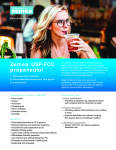Tate & Lyle hits the sweet spot
This content item was originally published on www.nutraingredients-usa.com, a William Reed online publication.
Tate & Lyle's Commercial and Food Innovation Center in suburban Chicago serves as the company's headquarters for new product development. The 110,000-square-foot building was designed to facilitate customer collaboration with its “idea to plate” concept, where food scientists meet with clients to test out new ingredients and recipes.
"So [it’s] a fun job to play with food quite a bit," said Susan Butler, senior technical category manager for nutrition and confectionery at Tate & Lyle. "I have a team of food scientists that are on my team focused in the nutrition and confectionery categories. So they're working with all of our ingredients and finding ways to make great tasting, good-for-you nutrition/confectionery products."
Less is more
With 18 years at Tate & Lyle, Butler has her finger on the pulse of ingredient trends. The one her team is focused on? Sugar reduction.
"A lot of the things that we're hearing from our customers is focused around sugar," said James Walsh, food scientist in the technical services department at Tate & Lyle. "I focus on the nutrition space. My part of the team is always hearing about sugar. How do we reduce it, but how do you make sure that everything tastes as good as you can? Nobody wants to have a no-sugar added beverage or confectionery that tastes terrible. They always want the best of both worlds and it's really about bridging that gap. That's mostly what we hear."
Walsh said that's where ingredients like allulose and Stevia come in. These ingredients are used in everything from protein bars to functional beverages to gummies. However, focus groups at Tate & Lyle revealed that not everyone is looking at the supplement facts panel.
“When you say a gummy has four grams of sugar, that doesn't mean much to anybody," he explained. "When you hold up a sugar cube and say, ‘This is two grams or four grams of sugar,’ now everybody's starting to think, wait, I have five or six different vitamins. So that means I'm taking six, seven, eight different cubes of sugar. And all of a sudden, once you had that in-person [demonstration], people got really, really interested in reducing the sugar. So normal gummies, even like a nutritional gummy, where you're only taking two, you're somewhere between four and six grams of sugar. So again, if you have say three gummies or three different vitamins, you might be having a can of Coke worth of sugar without even knowing it. And when we brought that up, everybody got very excited about reducing their sugar."
Consumer insights in focus
These conversations during the focus groups are what helped lead to many of the innovations at Tate & Lyle. The state-of-the-art facility is home to a number of laboratories, a full suite of consumer insight and sensory testing facilities, prototype manufacturing facilities and perhaps everyone's favorite: a demonstration kitchen.
The kitchen serves up lots of prototypes across a variety of categories, including beverages, dairy and non-dairy, bakery and snacks, and confectionery. Only in recent years has nutrition become a major focus, with gut healthy ingredients taking center stage.
Butler said the company's ingredient portfolio has evolved significantly in the last 5 to 6 years, with its soluble fiber portfolio in particular experiencing a lot of growth. Tate & Lyle also has dramatically expanded its sweeteners, boasting over 30 different Stevias in that portfolio.
Allulose and polyols are smaller molecules than sugar and tend to be softer, making them unsuitable for bars. Soluble fibers have the opposite effect and firm up the texture. The company also has a erythritol product called Erytesse. Combining these products with various fibers and combinations of fibers can optimize texture and taste.
Through its low and no calorie sweeteners and fibers, Tate & Lyle said it has taken four million tons of sugar out of people's diets with a target of nine million tons by 2025.




















